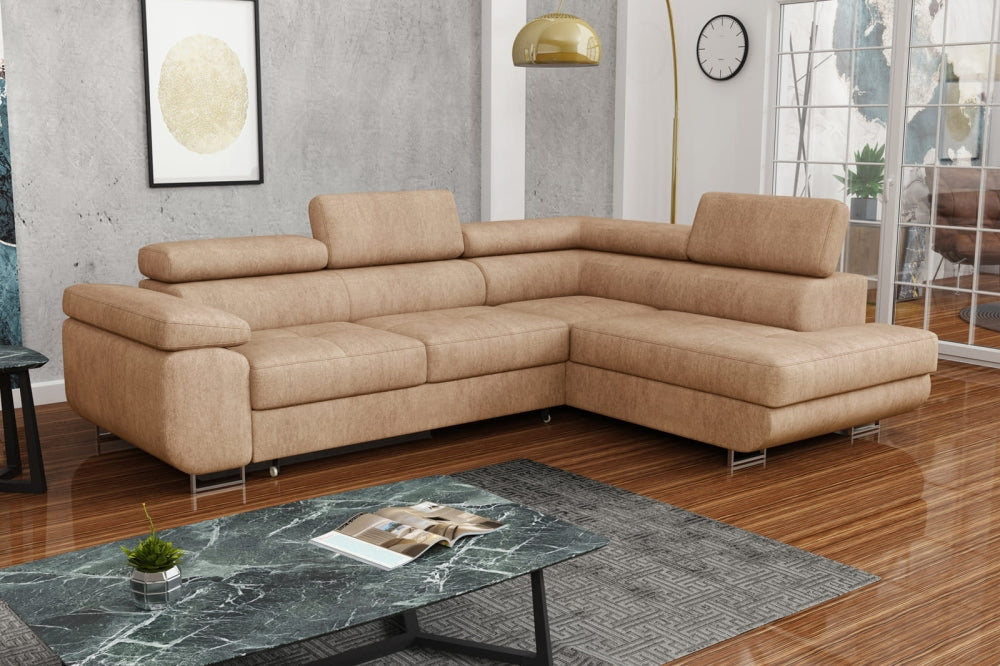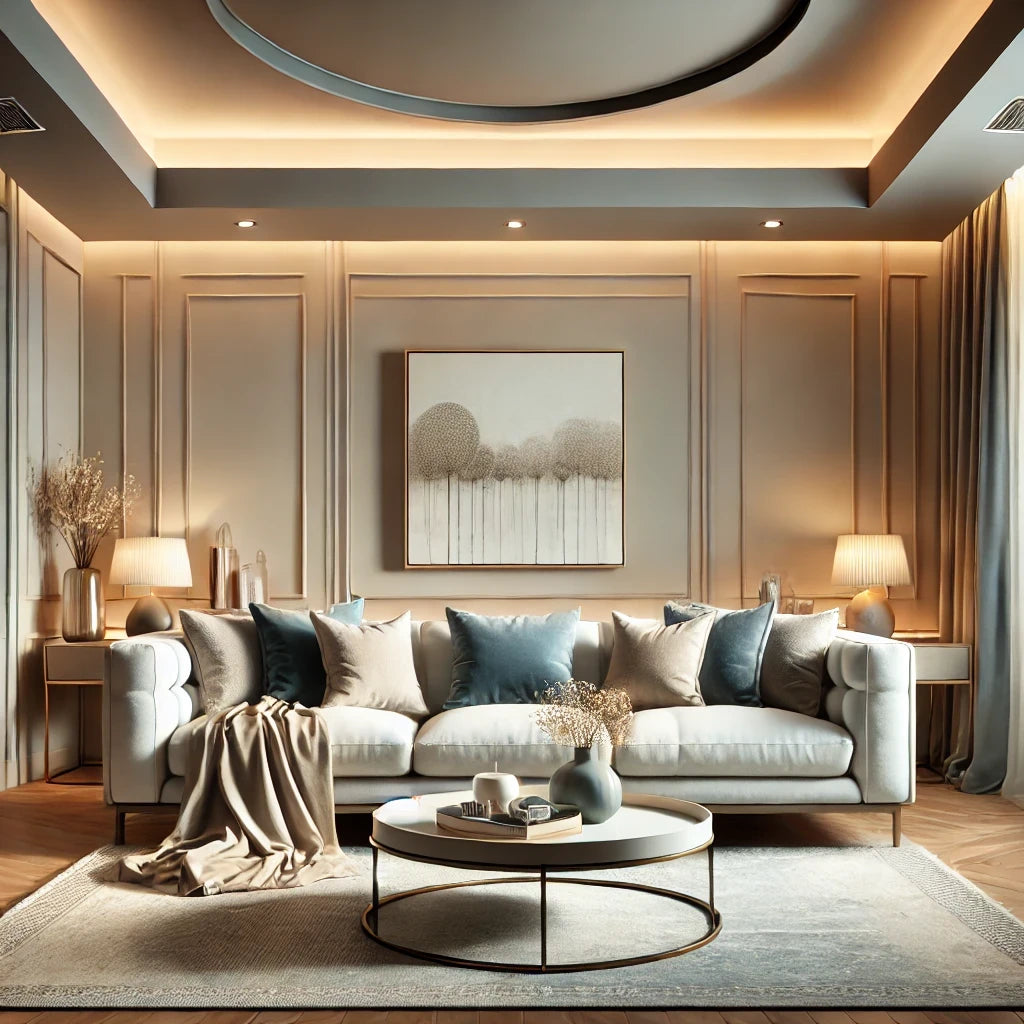1. Understanding Your Interior Style
Choosing a sofa for your living room is not just a matter of comfort but also aesthetics. The sofa is one of the most important pieces of furniture that greatly influences the overall character of the space. Therefore, before making a purchase, it’s crucial to consider the style that dominates your home.
If you prefer a modern style, your sofa should be simple, with clean lines and no unnecessary embellishments. In modern interiors, modular sofas work well, as they can be configured in various ways to suit your needs. Dominant colors include grays, beiges, and whites, often accented with bold colors like yellow or turquoise.
The Scandinavian style is characterized by light, natural colors and simplicity of form. In such interiors, sofas with a light structure and upholstery in natural-looking fabrics work best. Details like wooden legs can enhance the Scandinavian character of the piece.
For a classic style interior, consider sofas with more traditional forms. Leather upholstery, rich decorations, and deep, warm colors like burgundy or dark green will perfectly complement a classic living room.
For fans of the boho style, the best choice would be sofas with relaxed, somewhat eclectic forms, often covered in fabrics with ethnic patterns or rich colors. In such interiors, the sofa can be a focal point, attracting attention not only with its form but also with vibrant hues.
Regardless of the dominant style in your interior, the sofa should harmonize with the other elements of your decor, creating a cohesive and cozy space. A well-chosen sofa will not only complement the style of the interior but also highlight its unique character.
2. Size and Proportions
Choosing the right sofa for your living room is not just about aesthetics but, above all, about functionality. To serve its purpose, the sofa must be well-suited to the room's size. A sofa that is the wrong size can disrupt the room's proportions, making the space uncomfortable or uninviting.
In the case of small living rooms, it's advisable to opt for compact sofas. Two-seater sofas or modular sofas, which can be flexibly adjusted to the available space, are excellent choices. The key is to ensure that the sofa doesn’t overpower the room but rather works harmoniously with other furniture. It’s also important to avoid cluttering the space with unnecessary accessories, which will help maintain a sense of spaciousness.
In larger living rooms, you have more options. A corner sofa can become the centerpiece of the room, dividing it into zones, such as a seating area and a dining area. In spacious interiors, such sofas can be large, even several meters long, adding elegance and prestige to the space.
Another crucial aspect is the height of the sofa in relation to the rest of the furniture. A sofa that is too low or too high compared to the coffee table or chairs can disrupt the harmony of the interior. Therefore, it’s always worth paying attention to proportions to create a cohesive and functional space.
Examples of living room layouts can help you better visualize how the sofa will look in reality. For instance, in a small living room, a sofa placed against a wall might be the perfect solution to save space. In a larger living room, a sofa can be placed in the center of the room, creating a cozy seating area.
In summary, choosing the right size sofa is key to creating a harmonious and functional interior. Regardless of the size of the living room, a well-chosen sofa can make the space not only aesthetically pleasing but, above all, comfortable.
3. Functionality and User Needs
The functionality of the sofa is one of the most important factors to consider when choosing one. A sofa is not just a place to sit; it often serves other functions that need to be tailored to your lifestyle and the needs of your household.
If the sofa is primarily for relaxing after a long day at work, you should choose a model with a soft seat and deep cushions that provide maximum comfort. In this case, comfortable armrests and footrests are also important, allowing for full relaxation.
For those who frequently entertain guests, a sofa bed might be the ideal solution. These models are equipped with a mechanism that allows the sofa to be quickly and easily converted into a comfortable bed. This is particularly useful in apartments where there is no separate guest room.
If the sofa is to be a daily resting place for the whole family, consider a model with additional features such as adjustable headrests, extendable footrests, or built-in storage compartments for bedding and cushions. Such sofas are not only comfortable but also very practical, helping to keep the living room tidy.
For families with children or pets, the key aspect will be the durability and ease of cleaning the material from which the sofa is made. In this case, it’s worth choosing fabrics that are stain-resistant and easy to maintain, allowing you to enjoy the sofa for many years.
The number of household members and lifestyle greatly influence the choice of sofa. For one person, a small two-seater sofa might be sufficient, while for a larger family, a large, extendable corner sofa that accommodates everyone would be a better option.
In summary, the sofa should be tailored to your individual needs and lifestyle. Whether you need a place to relax, sleep, or store items, a well-chosen sofa will provide comfort and functionality in your daily life.
4. Choosing the Material and Color
Choosing the material and color of the sofa is a decision that will affect not only the appearance of your interior but also its functionality and durability. Upholstery fabrics vary in terms of durability, ease of cleaning, and aesthetics, so it’s important to carefully consider which material will be best for your home.
Leather is one of the most popular materials for sofas, especially in elegant, classic interiors. Leather sofas are not only durable but also easy to keep clean. Leather adds a touch of luxury to the interior, and with proper care, it can last for many years. However, leather sofas can be cool to the touch, which may not be to everyone’s liking, and they require regular moisturizing to maintain their suppleness.
Synthetic fabrics, such as microfiber, are a popular choice due to their durability and ease of cleaning. These materials are resistant to stains and wear, making them ideal for families with small children or pets. Additionally, synthetic fabrics are available in a wide range of colors and patterns, making it easy to match the sofa to your interior decor.
Velvet is a material that is making a comeback, especially in elegant, glamorous interiors. Velvet sofas are incredibly soft and pleasant to the touch, making them very comfortable. However, velvet is more demanding in terms of maintenance, as it stains easily and is prone to creasing. For those who value elegance and are willing to spend more time on care, velvet might be the perfect choice.
When it comes to the color of the sofa, it’s worth choosing one that will harmonize with the rest of the interior. Neutral colors like gray, beige, or white are versatile and easy to match with different decor styles. They are also practical, as they do not show stains or dirt as easily. Bold colors like red, navy blue, or green can become the focal point of the room, adding character and energy to it. However, it’s important to remember that strong colors can dominate the space, so it’s best to use them in spacious interiors or as an accent.
The choice of material and color for the sofa should be well thought out, as this is an investment for years to come. Whether you opt for leather, synthetic fabric, or velvet, the key is to choose a material that suits your needs and lifestyle, and a color that harmonizes with the rest of your interior.
5. Budget and Quality
When choosing a sofa, balancing budget and quality is crucial. A sofa is usually one of the more expensive investments in home furnishings, so it’s important to carefully consider what you’re willing to spend and what benefits you want to gain from it.
With sofas, the quality of materials and craftsmanship is closely tied to the price. Sofas in the higher price range are often made from better, more durable materials that ensure the longevity of the piece. High-quality construction, sturdy frames, resilient fillings, and meticulous finishes are features that translate into comfort and longer sofa life.
On the other hand, if you have a limited budget, it’s worth considering purchasing a sofa made from lower-standard materials but still durable and functional. In such cases, you can look for sofas on sale or models from previous collections, which are often offered at lower prices. It’s also worth looking for sofas made from synthetic materials, which can be cheaper but still offer good quality.
Investing in a more expensive sofa can be worthwhile if you plan to use it for the long term. Sofas made from high-quality materials can last for many years, and regular maintenance and care will ensure they look like new for a long time. It’s also worth noting that a higher price often means better customer service, a longer warranty, and the ability to customize the piece to your individual needs.
When purchasing a sofa, consider additional costs such as transportation, assembly, or possible accessories like protective covers. All these elements can impact the final purchase price.
In conclusion, choosing a sofa is a decision that should be carefully considered in terms of quality and budget. Regardless of how much you’re willing to spend, the key is that the sofa meets your expectations in terms of comfort, durability, and aesthetics. Investing in a high-quality sofa can prove to be a good choice, providing comfort and style for many years.


